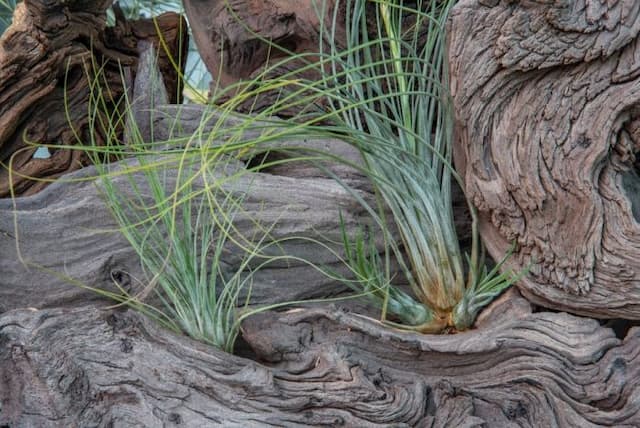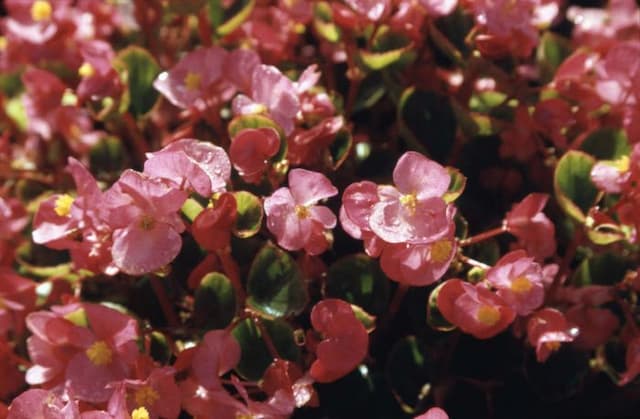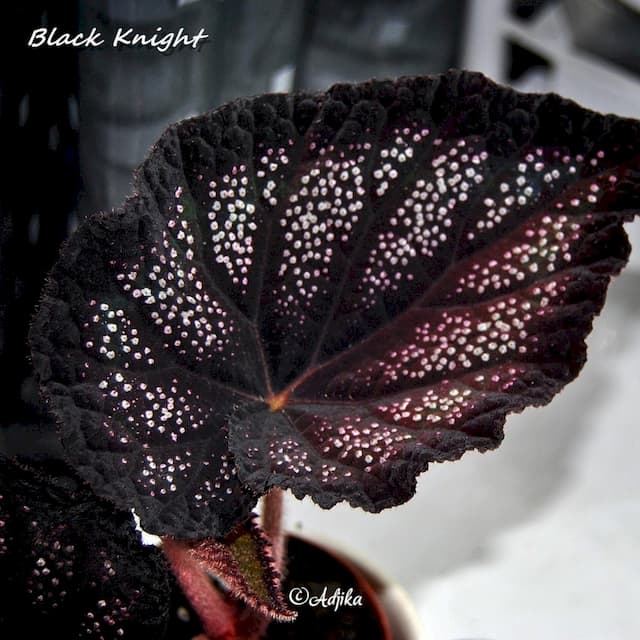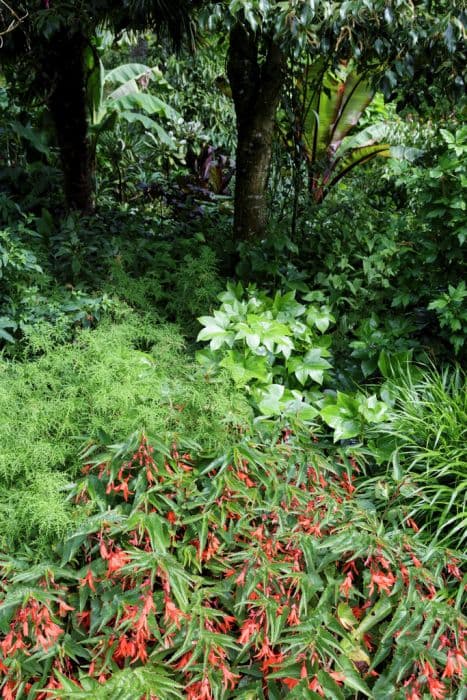Iron Cross Begonia Begonia 'Ironstone' (R)

ABOUT
Begonia 'Ironstone' is a visually striking plant characterized by its beautiful and distinctive foliage. This particular begonia features leaves that are a deep green hue, often with a metallic sheen that gives the impression of wrought iron, hence the name 'Ironstone'. The leaves may also exhibit unique patterns with lighter silver, gray, or even reddish-brown markings, adding to the plant's ornamental value. The texture of the leaves is also noteworthy; some variations may have a smooth and glossy surface, while others might feel more rugged or puckered to the touch. The edges of the leaves are typically gently serrated, providing a soft but defined silhouette. In terms of blooms, Begonia 'Ironstone' can produce flowers, but they are often understated compared to the foliage. The flowers can be found in clusters and are usually modest in size. The color of the blossoms varies, sometimes echoing the foliage with white, pink, or red tones that create a pleasing contrast against the dark leaves. Overall, the appearance of the Begonia 'Ironstone' is one of understated elegance and would make a vibrant addition to any plant collection or garden space, capturing attention with its unique, textural beauty.
About this plant
 Names
NamesFamily
Begoniaceae
Synonyms
Iron Cross Begonia, Ironstone Fancy-Leaf Begonia
Common names
Begonia 'Ironstone'
 Toxicity
ToxicityTo humans
Begonias, including Begonia 'Ironstone', contain insoluble oxalates which can be toxic when ingested. If parts of the plant are consumed, it can cause symptoms such as irritation of the mouth, lips, and throat, difficulty swallowing, and in severe cases vomiting. Contact with the sap may also cause skin irritation. In general, it is advisable to keep begonias out of reach and not to ingest any parts of the plant.
To pets
Begonias, including Begonia 'Ironstone', are also toxic to pets due to the presence of insoluble oxalates. If a pet ingests part of the plant, it may experience symptoms such as oral irritation, drooling, vomiting, and difficulty swallowing. In severe cases, ingestion can lead to more serious symptoms and veterinary attention might be required. It is best to prevent pets from accessing and chewing on any part of a begonia plant.
 Characteristics
CharacteristicsLife cycle
Perennials
Foliage type
Deciduous
Color of leaves
Mixed
Flower color
Pink
Height
1-2 feet (30-60 cm)
Spread
1-2 feet (30-60 cm)
Plant type
Herb
Hardiness zones
10
Native area
Tropical South America
Benefits
 General Benefits
General Benefits- Vibrant Foliage: Begonia Ironstone has attractive leaves that add a splash of color to gardens and indoor spaces.
- Low Maintenance: This plant is relatively easy to care for, requiring minimal upkeep and is forgiving of occasional neglect.
- Shade Tolerance: Begonia Ironstone can thrive in shaded areas where other plants might struggle, making it a versatile choice for different garden spots.
- Continuous Blooming: It produces flowers continuously during the growing season, providing a long-lasting display of blooms.
- Drought Resistance: Once established, it can tolerate periods of drought, though it prefers consistent moisture.
- Non-Invasive: This plant tends not to spread aggressively, making it a good neighbor to other plants in the garden.
- Cold Tolerant: It can survive in cooler temperatures better than many other begonia varieties, though it is still sensitive to frost.
- Container Gardening: Its compact size makes it well-suited for container or patio gardening, allowing for easy rearrangement and overwintering indoors if necessary.
- Pest-Resistant: Begonia Ironstone is fairly resistant to common garden pests, reducing the need for chemical treatments.
- Decorative Potential: With its striking appearance, it serves well as a focal point in floral arrangements and decorative plantings.
- Versatile: It can be used in landscaping as ground cover, in hanging baskets, or as a standalone ornamental plant.
 Medical Properties
Medical PropertiesThis plant is not used for medical purposes.
 Air-purifying Qualities
Air-purifying QualitiesThis plant is not specifically known for air purifying qualities.
 Other Uses
Other Uses- Begonia 'Ironstone' can be pressed and incorporated into handmade paper for a textural and visual effect.
- The waxy leaves of Begonia 'Ironstone' can be used to create botanical prints on fabric or paper through a process of hammering or steaming.
- The plant can serve as a living mulch, providing ground cover and helping to maintain soil moisture in gardens.
- Begonia 'Ironstone' can be used in terrariums or fairy gardens due to its compact size and decorative foliage.
- The vibrant, colorful leaves can be dried and used in scrapbooking or as natural art supplies for creating collages.
- Begonia 'Ironstone' can be part of a sensory garden, providing a variety of textures for tactile exploration.
- Leaves of the Begonia 'Ironstone' can be used as natural stencils for spray painting projects, leaving intricate patterns.
- This plant can be used as a model or subject in botanical illustration classes and workshops, teaching students about plant morphology.
- Begonia 'Ironstone' can be used as a natural dye source, where the leaves contribute subtle colors to textiles.
- The plant's unique appearance provides an attractive backdrop for photographing small items such as jewelry or other crafts.
Interesting Facts
 Feng Shui
Feng ShuiThe Begonia is not used in Feng Shui practice.
 Zodiac Sign Compitability
Zodiac Sign CompitabilityThe Begonia is not used in astrology practice.
 Plant Symbolism
Plant Symbolism- Caution - Begonias are often associated with a warning or caution, so the Begonia 'Ironstone' may symbolize the need for care in new endeavors or relationships.
- Uniqueness - The 'Ironstone' variety, with its distinctive foliage or flower, can represent someone's unique qualities or a reminder to embrace individuality.
- Harmony - Begonias are sometimes said to symbolize balance and harmony due to their asymmetrical leaves, which can relate to finding peace within oneself.
 Water
WaterFor the Iron Cross Begonia, it is important to maintain a consistent watering schedule that allows the soil to remain moist but not soggy. Water the plant thoroughly once the top inch of soil feels dry to the touch, which is approximately every 7-10 days, depending on environmental conditions. When watering, use room temperature water and gently pour it around the base of the plant until it begins to drain through the bottom of the pot. The exact amount of water needed can vary, but as a general guide, provide about 8-16 ounces per watering session, ensuring even soil moisture.
 Light
LightIron Cross Begonias thrive in bright, indirect sunlight. Place the plant near an east or west-facing window where it can receive gentle morning or evening sunlight. Avoid direct midday sun, which can scorch the foliage, and overly shady locations that can lead to leggy growth.
 Temperature
TemperatureIron Cross Begonias prefer temperatures between 65°F and 75°F during the day, and no less than 60°F at night. They can tolerate brief periods outside these ranges, but prolonged exposure to temperatures below 50°F or above 86°F can be harmful. Keeping the plant in a stable environment away from drafts and sudden temperature changes is ideal for its health.
 Pruning
PruningPruning is beneficial for the Iron Cross Begonia to remove dead or yellowing leaves and promote bushier growth. Trim off any unsightly or damaged foliage as necessary, using clean, sharp shears. The best time for more substantial pruning is in the spring or after the flowering period ends, to shape the plant and encourage vigor. Pruning should be done periodically, but always with a light hand, as the plant may not tolerate heavy cutting back.
 Cleaning
CleaningAs needed
 Soil
SoilBegonias, such as the 'Ironstone' variety, thrive best in light, well-draining soil with a slightly acidic pH of around 5.5 to 6.5. A good mix can be made by combining peat moss, perlite, and pine bark in equal parts. This recipe allows for proper aeration and drainage, which is critical to the health of the roots and overall plant vigor.
 Repotting
Repotting'Ironstone' Begonias should be repotted every 1-2 years to refresh the soil and prevent it from becoming compacted. This also provides an opportunity to check for root health and upsize the pot if the plant has outgrown its current home. The best time to repot is in the spring or early summer when the plant is beginning its active growth period.
 Humidity & Misting
Humidity & Misting'Ironstone' Begonias prefer a humidity level of around 50-60%. They thrive in a humid environment, which can be provided by grouping plants together, using a humidifier, or placing a water tray nearby. Consistently high humidity promotes healthy leaf and flower formation while helping to prevent pest problems.
 Suitable locations
Suitable locationsIndoor
Place in bright, indirect light and maintain high humidity.
Outdoor
Partial shade, protect from strong winds, and avoid frost.
Hardiness zone
10-11 USDA
 Life cycle
Life cycleBegonia 'Ironstone' begins its life as a seed or more commonly from a cutting or division due to its cultivated nature. After planting, the seed or cutting quickly sprouts, developing roots and shoots in the warm, moist conditions it favors. The juvenile stage is marked by the growth of characteristic asymmetrical leaves and the plant gradually matures, forming a bushy, herbaceous structure. During its maturity in favorable conditions, Begonia 'Ironstone' will produce clusters of delicate flowers, which can be pink, white, or red, depending on the cultivar. Once flowering is complete, it sets seeds, although cultivated varieties are often propagated vegetatively. With proper care, Begonia 'Ironstone' can live for several years, and after the plant completes its life cycle, it will die back, especially if exposed to temperatures below its tolerance, making way for new plants to be propagated from its seeds or cuttings.
 Propogation
PropogationPropogation time
Spring-Early Summer
Propogation: Begonia 'Ironstone' is often propagated through its leaves, which is considered the most popular method. This technique involves cutting a healthy leaf into pieces, each with at least one vein. Using a sharp, sterilized blade, you make cuts on the underside of the leaf to expose the veins. These leaf pieces are then laid flat on a moist growing medium like a peat-perlite mix or vermiculite, ensuring the cut veins are in contact with the substrate. The container with the leaf cuttings is then placed in a warm, brightly lit area, but out of direct sunlight, to encourage rooting. Humidity can be maintained by covering the container with a clear plastic bag or lid, which should be removed periodically to prevent fungal growth. Roots and new plantlets usually emerge within a few weeks, after which they can be potted up individually.



![Begonia [Allure]](/_next/image?url=https%3A%2F%2Fplants-admin.emdemapps.com%2Fimages%2Fplants%2F%2Fimages%2F604b5b9006ab9.png&w=640&q=75)





